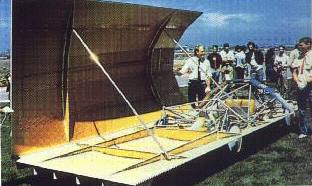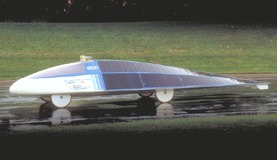|
GENERAL MOTORS - SUNRAYCER |
||||||||||||||||||||||||||||||||||||||||||||||||||||||||||||||||||||||||||||||||||||||||||||||||||||||||||||||||||||||||||||||||||||||||||||||||||||||||||||||||||||||||||||||||||||||||||||||||||||||||||||||||||||||||||||||||||||||||||||||||||||||||||||
|
HOME INDEX CAR MANUFACTURERS BLUEBIRD ELECTRIC ELECTRIC CARS E. CYCLES SOLAR CARS |
||||||||||||||||||||||||||||||||||||||||||||||||||||||||||||||||||||||||||||||||||||||||||||||||||||||||||||||||||||||||||||||||||||||||||||||||||||||||||||||||||||||||||||||||||||||||||||||||||||||||||||||||||||||||||||||||||||||||||||||||||||||||||||
|
In
1987, General Motors won the first World Solar Challenge in Australia. Its
record-setting car, Sunraycer, finished the race more than two days ahead
(600+ miles) of its closest competitor. Today, Sunraycer continues to take
center stage, at the Smithsonian Institution's Museum of American History
in Washington, D.C. Now, it lend's its name to the largest U.S.
competition for solar-powered vehicles - Sunrayce.
In
July 1990, 32 teams of some of North America's brightest college students
took to the road in solar-powered vehicles they had built during the
previous year and a half. The GM Sunrayce USA route covered more than
1,800 miles, from Florida to Michigan. Three of the top finishers won a
trip to Australia in November to compete in the 1990 world solar
challenge. Sunraycer
charging her batteries - this is allowed A
solar car is necessarily an electric car, because it runs on electricity
generated by solar heat. The first electrical carriage was built and
run in 1838 in Edinburgh, by one Robert Davidson, and a few years later an
American named M.B.Farmer was running one. In fact, the first auto
to break the 100 km/h 'barrier' was an electrically-driven torpedo-shaped LaJamais
Contente (The Never Content) which Belgian Camille Jenatzy pushed to a
new world land speed record of 105.904 km/h (65.79 mph) on April 29, 1899.
But the internal combustion engine was starting to demonstrate a
superiority that lasts until this day, as innovative technology continues
to refine this noble concept. Then,
88 years later, on October 31, 1987, the solar-charged, electric-powered
General Motors Sunraycer sprinted at 113 km/h (70.2 mph) on the highway
leading south from the far north Australian city of Darwin. what it
was doing Down Under is the story of this book. It
is the story of a highly diverse group of people brought together by the
common urge to push outwards the envelope of known technology. there
had been solar car races before. The first was the 1985 Tour de Sol
in Switzerland, over 229 miles, then the second in 1986, over 237 miles.
But the Australian race was 1950 miles across the world's oldest
continent. While Daimler-Benz had built its Solarmobile to win the
first Swiss race, the technology used would be outmoded instantly by what
was planned by the General Motors group of scientists, technicians,
designers, engineers and racers for the beautiful jewel called Sunraycer. This
book is the story of that Great Adventure, an operation that was planned
an executed with dazzling swiftness inside an excrutiatingly-tight
timetable, an incredible achievement in itself within the framework of so
vast a business organization. It
is the story of a race that was planned and won by an operation that in
its intensity of purpose and meticulousness of detail rivaled that of a
NASA space mission. And there were more than a few elements of
aerospace in what happened across that huge continent. That
is why in this book we refer to the GM team members as 'astronauts of the
sun'. This is their story, and the story of an amazing automobile. Sunraycer
charging her batteries - this is allowed The
Sunraycer will stand always as a symbol that America in general, and
General Motors in particular, is still in the forefront of innovative and
creative thinking. The country that put the world on wheels hasn't
forgotten how to lead. Sunraycer
is a product of the Australian-based Chevron Publishing Group. The
country's largest automotive and motor racing book and magazine publisher,
the group also produces books on other subjects. It has set new
standards of quality and excellence in Australian books, and as such, was
a worthy partner for the GM team in this endeavor. AFTER
THE SUNRAYCER - GM's EV1 After
GM's Sunraycer won the Australian race - it wasn't even a close race, the
Sunraycer crossed the finish line 2½ days before the second place racer.
This car heavily inspired the EV1 that is currently available. The Impact
was debuted ant the 1990 Los Angeles Auto Show. This was the first
prototype for the EV1. Twelve prototypes and 23 new patents later, the
first EV1 rolled of the assembly line at the Lansing Craft Centre in
November of 1996. The name Impact was dropped, probably because the term
doesn't sound safe. The car featured a 0.19 drag coefficient making it one
of the slickest cars ever. The car can even out run the Mazda Miata, no
small feat considering that electric cars are thought of as slow. In a
twist of irony, the EV1 sports the 100-year-old UL mark. Underwriters
Laboratories is the most widely accepted certification for electronic
gear. Both the charging system and car carry the mark. Take a careful look
at the EV1 on this page, it is the wave of the future. EV1
is by no means the first electric car on the U.S. mainland, it is however
one of the best conceived yet. Back at the last turn of the century,
electricity powered more "horseless carriages" than gasoline. As
was mentioned on the Oldsmobile page, had a fire not destroyed Ransom Olds
plant that produced electric cars, we might all be driving electric
vehicles today. Instead only a select few drive EV1's in some cities in
Arizona and California. Back in those early years electric cars were
popular because they didn't have to be hand cranked. They were also quiet
and didn't smell bad. These were big benefits in those days. However
history saw to it that the internal combustion engine won out and that is
what more than 99.999999% of the population drive. GM has toyed with
electric cars for the last few decades on and off. When the gas crisis hit
the U.S. in the early seventies and the emission controls started to
become a hot topic is when GM started to carefully look at electric cars.
This was in addition to other form of propulsion. However it was decided
that the technology was to new to be efficient enough for public
consumption. So the downsizing projects were under way to make the gas
powered cars lighter and more efficient. This worked well but did not
solve all of the problems, so research continued on for electric
vehicles. Congratulations to
the team for a job well done and for advancing
the cause of clean, sustainable, electric transportation.
The
Website is sponsored by Solar Cola
ORGANISATION
A-Z CAR'S
NAME TEAM
NAME Helios Faculty
of Engineering
Sol
of Auburn
Sol
of Auburn
Aurora
Aurora
Vehicle Association
Das
SolarCar der Fachhochschule
SLO
Burn Sidewinder
The
Solar Knights
Dark
Horse EAC
Skunkworks
Heliodet
Surya,
Ratha, Mercury Fusion Paragon
Tesseract McGill
University
Monteal, Canada McMaster
Uni Solar Car Project Genesis
II Solar Racing Team
The
Double Deuce Sunsetters
- Solar Race Team N'Uvation Het
Nuon Solar Team
OSU
model S
Solaris Sun
Panthers RA
6 Principia
College Solar
Car Team SPOT
2 Purdue
University
Solar Racing Queen's
University Canada Red
River College
Solar Car Team
Cougar
Cruiser Solar
Motion
Solstice
Tamagawa
Solar Challenge Project
FUTURA
2
Phaethon
model
Team
SunLake TOYOBO
Columbia
Sunraycer Texas
A&M Motorsports Team The
Power of One
- Toronto
Xof1
The
Xof1 solar car team
Drifter UC
Calgary
Solar Car Team Solution,
CATalyst
KSU
Solar Car Racing Team
Gato
del Sol II Borealis
III U
of M Solar
Vehicle Project Suntiger
VI The
Mizzou Solar Car Project
UOI
Solar Vehicle Team
UNSW
Sunswift III
Keystone
Queensland
Solar Team
Solar
Steer Solraycers Heliotrope
Solar Car Team
Sunseeker
05 |
||||||||||||||||||||||||||||||||||||||||||||||||||||||||||||||||||||||||||||||||||||||||||||||||||||||||||||||||||||||||||||||||||||||||||||||||||||||||||||||||||||||||||||||||||||||||||||||||||||||||||||||||||||||||||||||||||||||||||||||||||||||||||||
|

